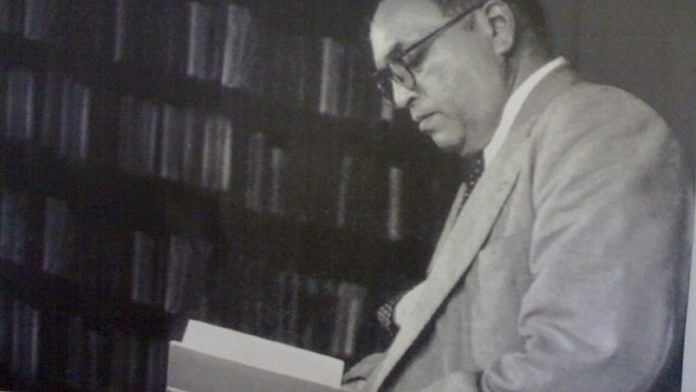Reading Dalit literature, we encounter an India that the urban upper-caste readers choose to ignore, or a definition of India we would rather not learn.
ThePrint is publishing articles on Dalit issues as part of Dalit History Month.
“Your Dalits seem to eat ghee and kansar, you should hear some of the other Dalit stories, there’s sheer starvation.”
My publisher was referring to Angaliyat, Gujarat’s first Dalit novel by Joseph Macwan. I had submitted its English translation, and the publisher was comparing it with English translations of Dalit stories she was receiving from other regions.
The publisher-friend’s observation has stayed with me as a guiding question: What might be the regional/class/gendered variations in the telling of a Dalit life?
Since Angaliyat, the Vankars of Gujarat have had more opportunities of livelihood and education, partly through the textile mills, and in some areas, the influence of Christianity. It is possible that a weaving community elsewhere may not have these; and equally possible that a weaving community elsewhere may not form part of the Scheduled Castes, but belong, rather to the other backward classes list.
An earlier and even more pioneering work, Baluta (1978) by Daya Pawar turns more inward than Angaliyat. An autobiography, perhaps the first one from Dalit writing, Baluta is one of the most profound studies of the self, split in this case between Daya and Dagdu. The politically established, acclaimed, and also contested figure of Daya Pawar asks his wandering, receding, haunting self for a story that needs to be told — a tale in fragments like its teller. Daya sketches a cartography of Bombay, the kawakhana, and the docks, through the unreliable memories of Dagdu.
When compared to Angaliyat, from its neighbouring region of Gujarat, the difference between the Marathi Baluta and Gujarati Angaliyat is striking. One is a stark account of a life and community, exposing, in the process, scabs that are both individual and collective; the other, that is Angaliyat, provides a handsome and epic narration.
Are these also the differences of svabhava, as in the regional nature and histories of the place, or individual temperament? Well, even within the same region, differences between two Dalit groups may be as irreconcilable as those between the Savarnas and the Dalits.
There can be different ways of asking the same question on the diversity of writing about the Dalit life, I suppose. For instance, a sociologist may look for demographic differences; a political scientist may begin with electoral representation. To some of us, Dalit literature provides a window into the empirical and experiential world of caste. It is as good, and as inadequate a beginning as any, to imagine the shades of emotions, the silences of the everyday life, and the persistent nature of caste-as-memory lying in both public and private repositories of the nation.
The body of Dalit literature is produced by those among the community who have found it possible to write and publish, coming from different sub-castes and regions and ideological hues. In their multilingual accounts (made available by translators), we encounter an India that the urban upper-caste readers choose to ignore, or a definition of India we would rather not learn. An insertion of a Dalit perspective changes the institutionalised accounts of nationalism, colonialism, modernity and the many political movements, just as Telangana and Naxalism.
As I say this, two instances of Dalit writing from very recent times come to mind.
Sujata Gidla’s Ants Among Elephants (2017) tells us the story of a Maoist rebel based on the life of an ‘untouchable’ Christian, and Manoranjan Byapari tells us his own story as a young Naxalite in Interrogating My Chandal Life (English translation in 2018). Gidla’s is also a rare example of an account written in English and by a diasporic writer. Byapari’s autobiography is translated from Bengali into English by Sipra Mukherjee.
“Our stories must wrench our own hearts into narratives, preferably in monochrome. We must bear witness to our own devastation so that you don’t have to confront your role in ours,” says Dhrubo Jyoti, poignantly and powerfully, in a book called Eleven Ways to Love (2018). Note how lessons of intersectionality are so hard to learn that it is possible to be both Dalit and queer and ask which of these forms of outside-ness is more difficult, and when.
Written as a series of letters to ‘P’, who is a Savarana and ‘bhadralok’ from Calcutta’s intellectual-academic circles, the queer-Dalit sender of letters brings to him, and by implication to us, the upper-caste readers of this English writing, a universe marked by the fragilities of sexuality and the impermeability of caste.
The question for identities removed from privileged centres is: Which ones will draw less backlash in which context? “I knew I couldn’t be gay and lower caste together. I knew I couldn’t fend off the little jabs and innocent queries and supportive pats. So I hid my caste away.”
My attention was drawn to this writing by my daughter, almost two decades after I first established my familiarity with Dalit literature. In these years, Dalit literature has expanded in more than ways than one. The immediacy and contemporary nature of Dhrubo Jyoti’s questions, Gidla’s diasporic and English-writing position, and Byapari’s account of a city we thought we knew, characterise new shifts in the Dalit discourse — shifts in which the body and range of expressions have increased, even as legislative and social transformation remain chequered.
Rita Kothari is professor (English) at Ashoka University.
Read more from ThePrint’s Dalit History Month archives.



